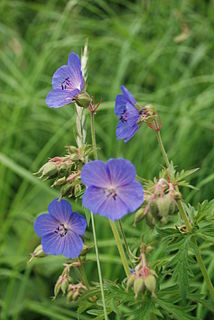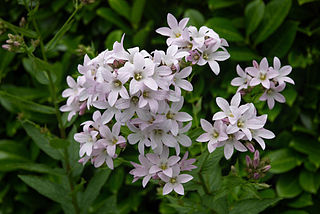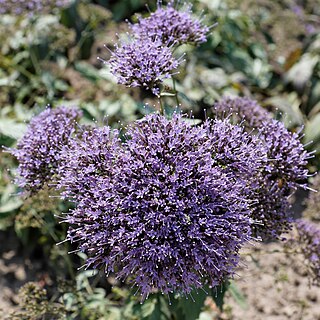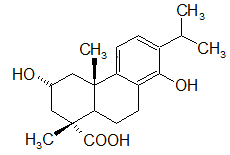
Geranium is a genus of 422 species of annual, biennial, and perennial plants that are commonly known as geraniums or cranesbills. They are found throughout the temperate regions of the world and the mountains of the tropics, but mostly in the eastern part of the Mediterranean region.

Salvia officinalis, the common sage or just sage, is a perennial, evergreen subshrub, with woody stems, grayish leaves, and blue to purplish flowers. It is a member of the mint family Lamiaceae and native to the Mediterranean region, though it has been naturalized in many places throughout the world. It has a long history of medicinal and culinary use, and in modern times it has been used as an ornamental garden plant. The common name "sage" is also used for closely related species and cultivars.

Osteospermum, is a genus of flowering plants belonging to the Calenduleae, one of the smaller tribes of the sunflower/daisy family Asteraceae. They are known as the daisybushes or African daisies.

Salvia yangii, previously known as Perovskia atriplicifolia, and commonly called Russian sage, is a flowering herbaceous perennial plant and subshrub. Although not previously a member of Salvia, the genus widely known as sage, since 2017 it has been included within them. It has an upright habit, typically reaching 0.5–1.2 m tall (1.6–3.9 ft), with square stems and grey-green leaves that yield a distinctive odor when crushed. It is best known for its flowers. Its flowering season extends from mid-summer to late October, with blue to violet blossoms arranged into showy, branched panicles.

Impatiens walleriana, also known as busy Lizzie, balsam, sultana, or simply impatiens, is a species of the genus Impatiens, native to eastern Africa from Kenya to Mozambique. The Latin specific epithet walleriana honours a British missionary, Horace Waller (1833–1896).

Salvia guaranitica, the anise-scented sage or hummingbird sage, is a species of flowering plant in the sage family Lamiaceae, native to a wide area of South America, including Brazil, Paraguay, Uruguay, and Argentina. It is cultivated all over the world, and is naturalized in New Zealand and Chile.

Salvia splendens, the scarlet sage, is a tender herbaceous perennial plant native to Brazil, growing at 2,000 to 3,000 m elevation where it is warm year-round and with high humidity. The wild form, rarely seen in cultivation, reaches 1.3 m (4.3 ft) tall. Smaller cultivars are very popular as bedding plants, seen in shopping malls and public gardens all over the world.

Salvia pratensis, the meadow clary or meadow sage, is a species of flowering plant in the family Lamiaceae, native to Europe, western Asia and northern Africa. The Latin specific epithet pratensis means "of meadows", referring to its preferred habitat. It also grows in scrub edges and woodland borders.

Symphyotrichum ericoides, known as white heath aster, frost aster, or heath aster, is a species of flowering plant in the family Asteraceae native to much of central and eastern North America. It has been introduced to parts of Europe and western Asia.

Salvia greggii, the autumn sage, is a herbaceous perennial plant native to a long, narrow area from southwest Texas, through the Chihuahuan Desert and into the Mexican state of San Luis Potosi, typically growing in rocky soils at elevations from 5,000 to 9,000 ft. It was named and described in 1870 by botanist Asa Gray after Josiah Gregg, a merchant, explorer, naturalist, and author from the American Southwest and Northern Mexico, who found and collected the plant in Texas. It is closely related to, and frequently hybridizes with, Salvia microphylla. Despite the common name "autumn sage", it blooms throughout the summer and autumn.

Geranium pratense, the meadow crane's-bill or meadow geranium, is a species of flowering plant in the family Geraniaceae, native to Europe and Asia. Forming a clump roughly 1 m (3.3 ft) tall and broad, it is a herbaceous perennial with hairy stems and lax saucer-shaped blooms of pale violet. It is extremely hardy to at least −20 °C (−4 °F), reflecting its origins in the Altai Mountains of central Asia.

Salvia candelabrum is a species of flowering plant in the family Lamiaceae, native to Spain. It is a woody-based perennial growing to 100 cm (39 in), with woolly grey-green leaves that resemble those of the common sage, S. officinalis, and emit a similar scent when crushed. In summer it bears violet-blue flowers on branching stems held high above the foliage.

Ipheion uniflorum is a species of flowering plant, related to the onions, so is placed in the allium subfamily (Allioideae) of the Amaryllidaceae. It is known by the common name springstar, or spring starflower. Along with all the species of the genus Ipheion, some sources place it in the genus Tristagma, but research published in 2010 suggested that this is not correct. It is native to Argentina and Uruguay, but is widely cultivated as an ornamental and reportedly naturalized in Great Britain, France, Australia, New Zealand and the United States.

Salvia involucrata, the roseleaf sage, is a species of flowering plant in the sage family Lamiaceae. This herbaceous perennial is native to the Mexican states of Puebla, Tamaulipas, and Veracruz, growing in shady places such as the edge of forests. Its specific epithet involucrata refers to the prominent flower bracts, which are large and colorful.

Salvia is the largest genus of plants in the sage family Lamiaceae, with nearly 1000 species of shrubs, herbaceous perennials, and annuals. Within the Lamiaceae, Salvia is part of the tribe Mentheae within the subfamily Nepetoideae. One of several genera commonly referred to as sage, it includes two widely used herbs, Salvia officinalis and Salvia rosmarinus.

The plant known as Salvia uliginosa, the bog sage, is a species of flowering plant in the family Lamiaceae, native to southern Brazil, Uruguay, and Argentina. It was described and named by botanist George Bentham for its typical habitat "of swamps and marshes", or uliginosa.

Salvia × superba is a widely grown Salvia hybrid. Its origins are unknown, though it first appeared in cultivation, and its parents are believed to include Salvia × sylvestris and Salvia amplexicaulis. Salvia nemorosa has also been suggested as a direct parent or close relative, but with so many similarities between these species and hybrids, there is no conclusive evidence. It is often mistakenly called Salvia superba.

Viola cornuta, known as horned pansy or horned violet, is a species of flowering plant in the violet family Violaceae, native to the Pyrenees and the Cordillera Cantábrica of northern Spain at an altitude of 1,000–2,300 metres (3,300–7,500 ft). It is a low-growing, clump-forming temperate evergreen perennial, reaching 50 cm (20 in) in height and spread. It has mid-green ovate leaves with rounded teeth, and masses of delicate pale violet flowers in early summer. The flower consists of five strap-shaped petals with a slender spur.

Campanula lactiflora, the milky bellflower, is a species of flowering plant in the genus Campanula of the family Campanulaceae, native to Turkey and the Caucasus. It is a medium-sized herbaceous perennial growing to 1.2 m, with narrow, toothed leaves 5–12 cm (2–5 in) long. Large conical clusters of open, star-shaped flowers are produced on branching stems in summer. In favourable conditions it will self-seed with variable results. The flowers are usually white or pale blue, but numerous cultivars have been developed for garden use, in a range of colours.

Trachelium caeruleum, common name blue throatwort, is a species of flowering plant in the family Campanulaceae native to the Mediterranean, where its native range includes Algeria, Morocco, Portugal, Spain, and Sicily. It has also become naturalized in a few areas, including New Zealand, the Azores, and parts of mainland Europe.




















